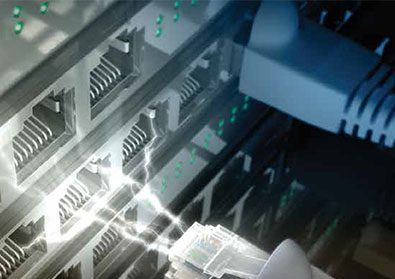
Fully Powered
PoE boosts efficiency while cutting costs
- By Ronnie Pennington
- Mar 01, 2013
 The term “alternative power” carries different meanings for security professionals. As the use of alternative wind and solar power increasingly finds its way into professional security applications for remote locations, new means of delivering power to core security and video surveillance devices continue to rapidly gain traction. More specifically, the ability to deliver video, data and power over Cat-5 Ethernet and coaxial cabling provides security professionals with an attractive solution for deploying highly-functional, networked systems with extreme cost-efficiency.
The term “alternative power” carries different meanings for security professionals. As the use of alternative wind and solar power increasingly finds its way into professional security applications for remote locations, new means of delivering power to core security and video surveillance devices continue to rapidly gain traction. More specifically, the ability to deliver video, data and power over Cat-5 Ethernet and coaxial cabling provides security professionals with an attractive solution for deploying highly-functional, networked systems with extreme cost-efficiency.
PoE Advantages
More and more system designers and installers are realizing the advantages of PoE. First used for VoIP telephones, PoE technology has gained popularity as a means of safely introducing power to other network devices via the same Cat-5 (or higher) cable that transmits Ethernet data. In security and surveillance systems, up to 15.4 watts can be supplied to network cameras and other devices using the original IEEE 802.3af standard. The newer IEEE 802.3af standard, also known as PoE+, can supply up to 25.5 watts of power to operate heaters and blowers for outdoor cameras, among other devices. A higher-power PoE standard on the horizon will provide even more power.
PoE is redefining how security professionals design and deploy systems. Rather than using the standard-type of power supplies, integrators are increasingly employing PoE network switches or incorporating PoE midspan devices that inject power into an Ethernet cable after it leaves the switch and before it reaches the network device.
Many integrators are already deploying PoE solutions. However, one common problem is that some existing PoE switches do not provide sufficient power for the end-point devices. Even non-security devices, such as newer, feature-packed, IP telephones, may draw more power than a PoE switch may supply. In such cases, a PoE midspan can provide the solution while simplifying power management and ensuring system functionality. Other advantages include scalability and flexibility, such as cascading for longer distances, and the ability to easily match the power requirements for an edge device.
PoE also ensures that power remains intact, even if a network connection is lost. For example, many IP cameras now can record images on an SD card, as a backup, if a lost network connection occurs, but the feature doesn’t work if the camera’s power supply is interrupted. With PoE midspans, cameras will still operate.
In addition, deploying managed midspans, with remote access via an IP address provides integrators and dealers with numerous advantages and benefits when installing, troubleshooting and servicing systems. This allows technicians to determine the current draw of each end-point device, the maximum current draw and how much power remains available from the midspan to connect additional devices.
Managed midspans also provide diagnostics to detect possible system problems and offer the ability to shut down power to individual ports for maintenance or when connecting devices. If a device needs a simple reboot, remote access allows installers to perform reboot functions without sending a technician to the job site. These features make system setup, service and maintenance much more efficient relative to the deployment of manpower into the field—a critical issue for applications in remote locations.
IP-Over-Coax Transforms Legacy Coax Cable into Network Infrastructure
There are millions of existing analog systems that use RG59 with separate power cabling for video surveillance applications. By employing IP-overcoax, Ethernet adapters, it is possible to upgrade systems from analog to IP, without having to rewire a facility with structured cabling. In addition to substantial cost savings, IP-over-coax also extends transmission distances over 1,500 feet without repeaters—Altronix eBridgePlus Ethernet Adapters, which is well beyond the Cat-5E/6 cable maximum of 328 feet. And when you add in the ability to simultaneously deliver PoE and PoE+ power over coaxial-cable infrastructure, the cost savings continue to add up by eliminating the equipment and labor expenses associated with installing localized power supplies.
IP-over-coax Ethernet adaptors allow video from multiple cameras to be transmitted on a single coax cable, by adding a switch at the camera end. When using IP cameras with composite video outputs, some Ethernet adapters can transmit both IP and composite video simultaneously, ensuring that video is always present on the coax for monitoring and recording purposes.
All of these advantages mean significant savings when migrating systems from analog to IP networked functionality, with virtually no sacrifice in system performance.
Considering alternative power sources from the perspective of both power generation and power delivery solutions, there are numerous possibilities to examine when implementing infrastructure upgrades and new installs. Combining power generation sources, like wind and/or solar, can provide the means to deploy advanced security solutions in remote locations, where power is not easily delivered. The benefits also apply to facilities looking to take advantage of installing their own power generation capabilities to reduce long-term, recurring, overhead, power expenses. In either case, these power generation technologies can easily be complemented with traditional, localized power supplies, PoE, or IP-overcoax technology. The combination of various, alternative energy solutions opens up new realms of possibilities for system designers. The key is getting past the semantics first, and approaching old challenges with a new mindset.
This article originally appeared in the March 2013 issue of Security Today.